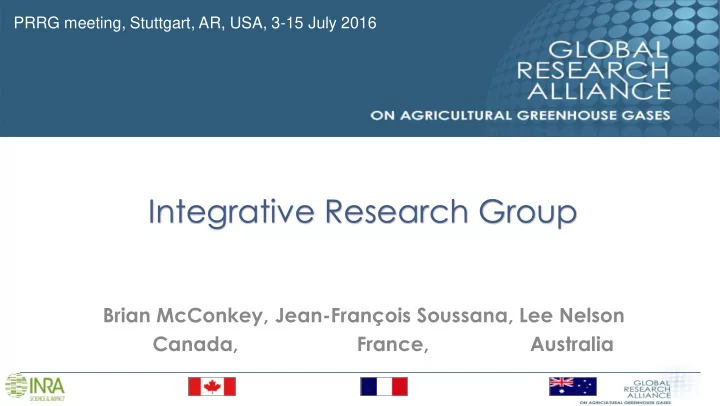

PRRG meeting, Stuttgart, AR, USA, 3-15 July 2016 Integrative Research Group Brian McConkey, Jean-François Soussana, Lee Nelson Canada, France, Australia
Integrative Research Group (IRG) Its overarching aim is to develop the knowledge and capabilities to • estimate, monitor, and project GHG emissions within and across agricultural systems through research, development, and knowledge transfer. Its actions involves applying, reporting, monitoring, and/or verifying • greenhouse gas emission estimates across farming systems to subnational, national, and supranational scales. Work with and between the existing Livestock Research Group (LRG), • Cropland Research Group (CRG) and Paddy Rice Research Group (PRRG) 2
IRG Builds and expands on the work of the former C&N Cycling and Inventories and • Monitoring Cross-Cutting Groups • Members and partners participate and connect with IRG for cross-cutting issues that do not fit well under one of the Livestock, Cropland, and/or Paddy Rice Research Groups • Science such as: livestock-land interactions, carbon sequestration • Science-policy interface such as: inventories, mitigation costing for farming systems • Integrated analyses involving mitigation and adaptation Work done through networks that assemble necessary expertise and resources to • accomplish their goals • 5 networks currently • Grasslands, Field-Scale, Carbon Sequestration, Farm- and Regional-Scale, GHG Inventories 3
Grassland Network Builds on former Grassland network within the Livestock Research Group • • Coordinators: Fernando Lattanzi (INIA, Uruguay), Karl Richards (Teagasc, Ireland), Data and best management practices for grasslands (by region, and by practice, for • productivity, quality, soil carbon, N2O, etc.). Three topics of interest: • • Grassland management and greenhouse gases emissions, • Costing best practices (e.g. for tropical pasture intensification), • Mixed systems (temporary grasslands, integrated systems). Links to Livestock Research Group (e.g. for grazing and feeding regimes, manure • management, integrated grassland and livestock management, etc.). Links to Croplands Research Group (e.g. for sown grasslands, crop rotations, etc.). • 4
Field-Scale Network Field (point) scale (builds on the former soil C-N cycling cross-cutting group) • • Coordinators: Pete Smith (Aberdeen U., UK), Jean-Francois Soussana (INRA, France), I ntegrating models and data at the field scale for grasslands, crops and mixed systems • – Crop and grassland models intercomparison and benchmarking for yields and GHGs (work done in the previous C&N group, almost finished), – Climate sensitivity of GHG models, – Modeling mitigation and adaptation options, – Statistical emulators for upscaling. Links to Croplands Research Group (CRG) activities (e.g. GRAMP modeling platform, • data bases) and to Livestock Research Group activities (e.g. for GHG balance modeling of livestock systems). 5
Carbon Sequestration Network New network • • Coordinators: Denis Angers (AAFC, Canada), Claire Chenu (AgroParisTech, France), Soil carbon sequestration potential across spatial and temporal scales and developing • reliable low-cost monitoring and verification methods. • Data base showing soil C sequestration (or loss) rates vs. systems and practices, with effects on productivity, C-N-water cycles and non-CO2 GHGs (to be linked with data bases from other groups), • Simple soil models for advancing process understanding (e.g. mean residence time, stabilization, etc.), • Meta-analyses and modeling showing soil C sequestration potential and associated effects of increased soil OM, • Methods for soil carbon monitoring, reporting and verifying (MRV) at local scale. Integrates knowledge on soil carbon across networks and in collaboration with the CRG, • LRG and PRRG. 6
Farm- and Regional-Scale Network New network • • Coordinators: Richard Eckard (Melbourne U., Australia), Petr Havlik (IIASA, Austria), Generic and robust understanding of reducing GHG emissions and storing soil • carbon through improved practices and changes in production systems at scales ranging from the farm to the region, also including agricultural landscapes. • Demonstration farm network showing effects of improved practices, • Simple farm scale calculators showing changes in productivity, soil carbon and adaptation/mitigation strategies, • Pilot regions assessment studies, • A toolbox for developing national/ regional studies. This will be achieved through integration of knowledge across networks and in • collaboration with the CRG, LRG and PRRG groups. 7
GHG Inventories Network Builds on the former Inventories and Methods Cross-Cutting Group • • Coordinators: Brian Mc Conkey (AAF, Canada), Jan Verhagen (WUR, Netherlands). Improving national GHG inventories, systems level and all gases, options for • improved activity description, for Tier 2 and Tier 3 in sub-sectors, mobilizing GRA activities for use by countries for inventories and national communications • Guidance on how to improve inventories, including data on activities, • Moving to Tier 2, sharing examples from countries, • Emission factors and activity data for farming systems This network will integrate knowledge from other networks and groups and translate • it in formats that can advance national inventories and communications. 8
IRG Operation The IRG will reach its goals through the actions of the individual • networks, cross-network collaborations, and collaborations between networks and LRG, CRG, and/or PRRG • IRG work is guided by the co-chairs and the network coordinators with input from RG co-chairs, and Member representatives to the IRG • Networks have freedom to involve expertise and resources from outside GRA and its partners All networks will contribute to cross-cutting activities, such as capacity • building, knowledge transfer and communication Communication, interaction, and coordination between networks and • with other RGs are critical 9
Paddy Rice Research Group and IRG • What are the opportunities that the PRRG would like to collaborate with the IRG • What topics and which networks? • Funding, human resources, and partners? • What are some valuable outputs that could be produced within 12 months from that collaboration? 10
Recommend
More recommend